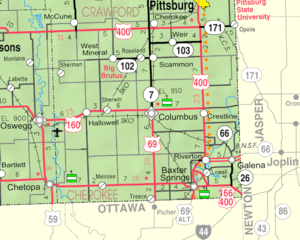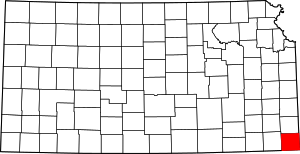Columbus, Kansas
Columbus is the second largest city and county seat of Cherokee County, Kansas, United States. It is located approximately 15 miles south-southwest of Pittsburg. As of the 2010 census, the city population was 3,312.[6]
Columbus, Kansas | |
|---|---|
City and County seat | |
 Columbus Carnegie Library (2013) | |
| Motto(s): "Help America Discover Columbus..."[1] | |
 Location within Cherokee County and Kansas | |
 KDOT map of Cherokee County (legend) | |
| Coordinates: 37°10′17″N 94°50′27″W | |
| Country | United States |
| State | Kansas |
| County | Cherokee |
| Founded | 1868 |
| Incorporated | 1871 |
| Named for | Columbus, Ohio |
| Area | |
| • Total | 2.39 sq mi (6.20 km2) |
| • Land | 2.39 sq mi (6.20 km2) |
| • Water | 0.00 sq mi (0.00 km2) |
| Elevation | 912 ft (278 m) |
| Population | |
| • Total | 3,312 |
| • Estimate (2019)[4] | 3,052 |
| • Density | 1,275.39/sq mi (492.38/km2) |
| Time zone | UTC-6 (CST) |
| • Summer (DST) | UTC-5 (CDT) |
| ZIP code | 66725 |
| Area code | 620 |
| FIPS code | 20-15075 |
| GNIS ID | 0469479 [5] |
| Website | columbuscityhall.com |
History
The first settlement was made at Columbus in 1868.[7] The first post office in Columbus was established in 1869.[8]
Columbus was a railroad junction for the Saint Louis and San Francisco, and the Missouri, Kansas, and Texas railroads. It was named Columbus by A.L. Peters, one of the European-American founders, for his hometown of Columbus, Ohio; the name thus indirectly honors Christopher Columbus, the explorer.[9][10] Coal, lead and zinc were mined in the region. Columbus had a considerable trade in agricultural products, and its businesses included machine shops, grain elevators, flour mills, a cigar factory, bottle works (soft drinks), a canning factory, and an extensive brick-making plant.[11]
In 1875, Robert A. Long and Victor Bell formed the Long-Bell Lumber Company in Columbus. From one lumberyard, Long-Bell expanded operations and holdings to become one of the largest vertically integrated lumber companies in the United States. In 1956 it was purchased by International Paper.[12]
Geography
Columbus is located at 37°10′17″N 94°50′27″W (37.171379, -94.840704).[13] According to the United States Census Bureau, the city has a total area of 2.42 square miles (6.27 km2), all of it land.[14]
Climate
The climate in this area is characterized by hot, humid summers and generally mild to cool winters. According to the Köppen Climate Classification system, Columbus has a humid subtropical climate, abbreviated "Cfa" on climate maps.[15]
Demographics
| Historical population | |||
|---|---|---|---|
| Census | Pop. | %± | |
| 1870 | 402 | — | |
| 1880 | 1,164 | 189.6% | |
| 1890 | 2,160 | 85.6% | |
| 1900 | 2,310 | 6.9% | |
| 1910 | 3,064 | 32.6% | |
| 1920 | 3,155 | 3.0% | |
| 1930 | 3,235 | 2.5% | |
| 1940 | 3,402 | 5.2% | |
| 1950 | 3,490 | 2.6% | |
| 1960 | 3,395 | −2.7% | |
| 1970 | 3,356 | −1.1% | |
| 1980 | 3,426 | 2.1% | |
| 1990 | 3,268 | −4.6% | |
| 2000 | 3,396 | 3.9% | |
| 2010 | 3,312 | −2.5% | |
| Est. 2019 | 3,052 | [4] | −7.9% |
| U.S. Decennial Census[16] 2012 Estimate[17] | |||
2010 census
As of the census[3] of 2010, there were 3,312 people, 1,424 households, and 850 families living in the city. The population density was 1,368.6 inhabitants per square mile (528.4/km2). There were 1,633 housing units at an average density of 674.8 per square mile (260.5/km2). The racial makeup of the city was 92.9% White, 0.5% African American, 2.7% Native American, 0.3% Asian, 0.4% from other races, and 3.3% from two or more races. Hispanic or Latino of any race were 2.1% of the population.
There were 1,424 households of which 30.3% had children under the age of 18 living with them, 42.1% were married couples living together, 13.6% had a female householder with no husband present, 4.1% had a male householder with no wife present, and 40.3% were non-families. 34.9% of all households were made up of individuals and 19.3% had someone living alone who was 65 years of age or older. The average household size was 2.29 and the average family size was 2.94.
The median age in the city was 39.1 years. 25% of residents were under the age of 18; 8.9% were between the ages of 18 and 24; 22.6% were from 25 to 44; 23.8% were from 45 to 64; and 19.7% were 65 years of age or older. The gender makeup of the city was 46.4% male and 53.6% female.
2000 census
As of the census of 2000, there were 3,396 people, 1,412 households, and 885 families living in the city. The population density was 1,408.6 people per square mile (544.1/km2). There were 1,610 housing units at an average density of 667.8 per square mile (257.9/km2). The racial makeup of the city was 94.70% White, 0.32% African American, 1.56% Native American, 0.41% Asian, 0.77% from other races, and 2.24% from two or more races. Hispanic or Latino of any race were 2.03% of the population.
There were 1,412 households out of which 29.7% had children under the age of 18 living with them, 47.5% were married couples living together, 11.3% had a female householder with no husband present, and 37.3% were non-families. 34.5% of all households were made up of individuals and 18.7% had someone living alone who was 65 years of age or older. The average household size was 2.30 and the average family size was 2.94.
In the city, the population was spread out with 26.3% under the age of 18, 8.4% from 18 to 24, 24.3% from 25 to 44, 20.7% from 45 to 64, and 20.3% who were 65 years of age or older. The median age was 38 years. For every 100 females, there were 82.1 males. For every 100 females age 18 and over, there were 78.1 males.
The median income for a household in the city was $27,530, and the median income for a family was $38,136. Males had a median income of $30,541 versus $17,069 for females. The per capita income for the city was $14,937. About 12.2% of families and 16.2% of the population were below the poverty line, including 23.1% of those under age 18 and 8.3% of those age 65 or over.
Notable people
- Marcellus Boss, 5th Civilian Governor of Guam
- Elizabeth W. Crandall, educator
- James Reed Hallowell, politician
- Robert A. Long, lumber baron, developer, investor, newspaper owner, and philanthropist
- Doro Merande, film, stage and television actress
- Merle Evans, bandleader for Ringling Brothers, Barnum & Bailey Circus
- Kenneth A. Spencer, industrialist
- Norma Terris, singer and actress
- Leland Justin Webb, 1st Mayor of Columbus, lawyer, served in American Civil War and 19th Kansas Cavalry Regiment
- Thomas Daniel Winter, US Representative from Kansas, 1939–1947.
References
- "Columbus Chamber of Commerce". Columbus Chamber of Commerce. Archived from the original on July 22, 2012. Retrieved August 17, 2012.
- "2019 U.S. Gazetteer Files". United States Census Bureau. Retrieved July 24, 2020.
- "U.S. Census website". United States Census Bureau. Retrieved 2012-07-06.
- "Population and Housing Unit Estimates". United States Census Bureau. May 24, 2020. Retrieved May 27, 2020.
- "US Board on Geographic Names". United States Geological Survey. 2007-10-25. Retrieved 2008-01-31.
- "2010 City Population and Housing Occupancy Status". U.S. Census Bureau. Retrieved March 6, 2011.
- Blackmar, Frank Wilson (1912). Kansas: A Cyclopedia of State History, Embracing Events, Institutions, Industries, Counties, Cities, Towns, Prominent Persons, Etc. Standard Publishing Company. pp. 391.
- "Kansas Post Offices, 1828-1961 (archived)". Kansas Historical Society. Archived from the original on October 9, 2013. Retrieved 6 June 2014.
- John Rydjord, Kansas Place-Names, University of Oklahoma Press, 1972, ISBN 0-8061-0994-7
- The Modern Light, Columbus, August 16, 1951
- "Archived copy". Archived from the original on 2009-07-02. Retrieved 2009-03-28.CS1 maint: archived copy as title (link)
- William E. Connelley, A Standard History of Kansas and Kansans,, Chicago: Lewis Publishing Company, 1918
- "US Gazetteer files: 2010, 2000, and 1990". United States Census Bureau. 2011-02-12. Retrieved 2011-04-23.
- "US Gazetteer files 2010". United States Census Bureau. Archived from the original on 2012-07-02. Retrieved 2012-07-06.
- Climate Summary for Columbus, Kansas
- United States Census Bureau. "Census of Population and Housing". Retrieved February 15, 2014.
- "Annual Estimates of the Resident Population: April 1, 2010 to July 1, 2012". Archived from the original on November 20, 2013. Retrieved February 15, 2014.
Further reading
External links
| Wikimedia Commons has media related to Columbus, Kansas. |
| Wikisource has the text of a 1905 New International Encyclopedia article about Columbus, Kansas. |
- City
- Schools
- USD 493, local school district
- Historical
- Historic Images of Columbus, Special Photo Collections at Wichita State University Library
- Maps
- Columbus City Map, KDOT
